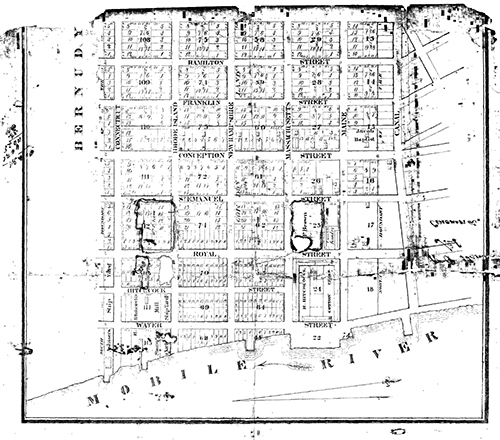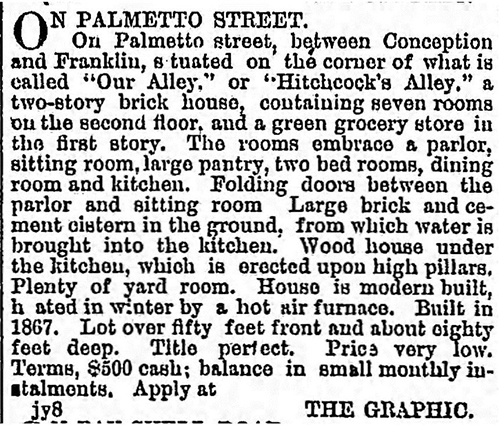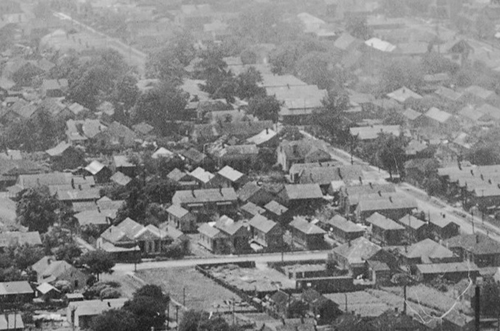Mapping Memory: Our Alley
Posted on June 5, 2024 by Candice Fairchild
Of the many noteworthy locations nestled within the Down the Bay neighborhood, sat “Our Alley.” Our Alley no longer exists because of the construction of I-10—the highway now runs exactly where the alley once did. Our Alley was known for many things: its size, its sounds, and its history of cheap, white-owned rental properties. Our Alley existed as early as 1839; the map below is the earliest reference we’ve found to the street.

1839 Map of the Bernoudy Tract in Mobile. Our alley runs between Franklin and Conception Streets in the top half of the map. This map shows the pre-Civil War street names; streets like Maine and Massachusetts were changed to Palmetto and Charleston respectively to remove their northern affiliations. Map courtesy of the Minnie Mitchell Archives at the Historic Mobile Preservation Society.
The alley sat between South Conception and South Franklin Streets and ran from Maine Street (today Palmetto) to Delaware. As indicated by the map, this is a remarkably expansive alley. Rental homes were built on Our Alley as early as 1874. A clipping from the Mobile Daily Tribune (below) describes a rental property built in 1867 available for sale on Hitchcock’s Alley with a price that was “very low.” Hitchcock’s Alley was named for Henry Hitchcock, an early lawyer and businessman in Mobile during the 1800s who initially owned much of the property along Our Alley.

Mobile Daily Tribune article from November 4, 1874.
Many people attribute the growth of Our Alley to the aftermath of the 1919 fire, which started nearby on South Hamilton and Madison Streets and burned 40 blocks in downtown Mobile. Black residents who lost their homes in the fire resettled into Our Alley, where white property owners built cheap rentals in their backyards to capitalize on their displacement. In his book Gunny: Memoirs of Mobile’s Southside Riding Alabama’s Tide of White Supremacy (2007), James Joullian Gonzales notes that, by way of low rent, Black residents were pushed to resettle into Our Alley. The alley was marked by a “high wood fence” that served to separate Black residents from white residents.
In her 2023 interview with Dr. Kern Jackson for the Down the Bay Oral History Project, Bernice Arnold Russell shares how Our Alley was seen as a last resort for those in the neighborhood:
Russell: And it was kinda like, I don’t even know what to say about that but it was a lot of people that lived in there. Jackson: I mean I’m trying to figure out what was unique about it. Russell: Nothing! You wouldn’t want to live in there.
Mrs. Russell goes on to explain that Our Alley wasn’t a “rough” place to live, but that “it was like, that’s your last chance. Last chance if you gone live in—you ain’t got nowhere else to go.” Our Alley’s negative reputation, as described by Mrs. Russell, highlights the impact of white property owners’ corrupt business practices on struggling families.

1922 aerial image showing dense housing along Our Alley between Texas and Elmira Streets. Houses can be seen directly behind the row of shotgun houses in the foreground. Image courtesy of the National Archives.
Despite its history founded in systemic racism, Our Alley was also known for its vibrancy of life and sound. Many residents of Our Alley possessed musical talents, forming rhythm and blues bands that played from porches lining the length of the alley. This made the alley a hub of musical expression, as many former residents recall. Notably, Creola Gibby Ruffin who lived along Our Alley remembers the space’s music:
“I played piano, my next door neighbors played piano and sang, then they eventually started a rhythm in blues group. I had a best friend who lived not far next to Bodiford’s Grocery who played all instruments. So you know that was a good pastime for us because we got together and played music. So with the music playing and in between my house and our neighbors house there were alleys Down the Bay. This alley was called Our Alley.” -Creola Gibby Ruffin, 2022
By recalling the music of Our Alley, Ruffin highlights how there was a community there who defied circumstance by bringing life and vibrancy to a place that was meant to stifle. Their music worked, in some ways, to subvert the goals of white property owners, demonstrating a spirit of resilience and resourcefulness that was housed in Our Alley. Although Our Alley was developed by predatory landlords and served as a last resort, its residents used what they had to make it a home.
By: Candice Fairchild
Candice Fairchild is a second-year Ph.D. student in English at the University of Alabama. Candice has worked as a transcriber for the Down the Bay Oral History Project and finds inspiration for her blog posts from her experience listening to and transcribing those interviews.
Check the other posts in the Mapping Memory series, which shares place-based memories from the Down the Bay Oral History Project:
Mapping Memory: Harlem Theater


